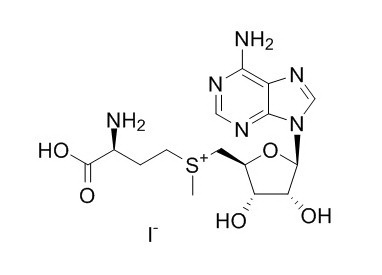S-Adenosyl-L-Methionine iodide salt
Reference standards.
Inquire / Order:
manager@chemfaces.com
Technical Inquiries:
service@chemfaces.com
Tel:
+86-27-84237783
Fax:
+86-27-84254680
Address:
1 Building, No. 83, CheCheng Rd., Wuhan Economic and Technological Development Zone, Wuhan, Hubei 430056, PRC
Providing storage is as stated on the product vial and the vial is kept tightly sealed, the product can be stored for up to
24 months(2-8C).
Wherever possible, you should prepare and use solutions on the same day. However, if you need to make up stock solutions in advance, we recommend that you store the solution as aliquots in tightly sealed vials at -20C. Generally, these will be useable for up to two weeks. Before use, and prior to opening the vial we recommend that you allow your product to equilibrate to room temperature for at least 1 hour.
Need more advice on solubility, usage and handling? Please email to: service@chemfaces.com
The packaging of the product may have turned upside down during transportation, resulting in the natural compounds adhering to the neck or cap of the vial. take the vial out of its packaging and gently shake to let the compounds fall to the bottom of the vial. for liquid products, centrifuge at 200-500 RPM to gather the liquid at the bottom of the vial. try to avoid loss or contamination during handling.
Food Res Int.2022, 157:111207.
Planta Med.2023, 2192-2281
Molecules.2020, 25(3):734
Exp Mol Med.2020, 52(4):629-642.
Korean Journal of Pharmacognosy.2019, 50(1):65-71
Nutrients.2019, 12(1):E40
Emirates Journal of Food and Agriculture.2022, 34(6): 528-536.
Regul Toxicol Pharmacol.2024, 149:105620.
Curr Issues Mol Biol.2023, 45(3):2136-2156.
Foods.2024, 13(23):3861.
Related and Featured Products
Planta,2004,220:278–285.
Salt stress enhances xylem development and expression of S-adenosyl-L-methionine synthase in lignifying tissues of tomato plants.[Reference:
WebLink]
S-Adenosyl-L-methionine synthase (SAM; ATP:L-methionine adenosyltransferase, EC 2.5.1.6) catalyzes the biosynthesis of S-adenosyl-L-methionine (AdoMet), a universal methyl-group donor. This enzyme is induced by salinity stress in tomato (Lycopersicon esculentum Mill.).
METHODS AND RESULTS:
To elucidate the role of SAM and AdoMet in the adaptation of plants to a saline environment, the expression pattern and histological distribution of SAM was investigated in control and salt-stressed tomato plants. Immunohistochemical analysis showed that SAM proteins were expressed in all cell types and plant organs, albeit with preferential accumulation in lignified tissues. Lignin deposition was estimated by histochemical tests and the extent of tissue lignification in response to salinity was quantified by image analysis. The average number of lignified cells in vascular bundles was significantly greater in plants under salt stress, with a maximal expansion of the lignified area found in the root vasculature. Accordingly, the greatest abundance of SAM gene transcripts and proteins occurred in roots.
CONCLUSIONS:
These results indicate that increased SAM activity correlated with a greater deposition of lignin in the vascular tissues of plants under salinity stress. A model is proposed in which an increased number of lignified tracheary elements in tomato roots under salt stress may enhance the cell-to-cell pathway for water transport, which would impart greater selectivity and reduced ion uptake, and compensate for diminished bulk flow of water and solutes along the apoplastic pathway.



